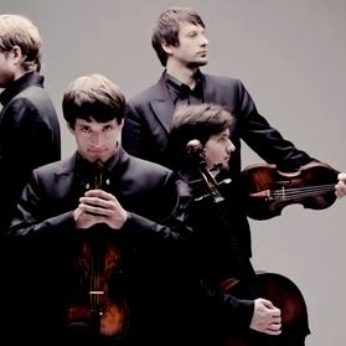Composer: Pyotr Ilyich Tchaikovsky (b. 1840 - d. 1893)
Performance date: 30/06/2012
Venue: Bantry Library
Composition Year: 1871
Duration: 00:29:02
Recording Engineer: Anton Timoney, RTÉ lyric fm
Instrumentation: vn, va, vc
Instrumentation Category:String Quartet
Artists:
Apollon Musagète Quartet (Paweł Zalejski, Bartosz Zachłod [violins], Piotr Szumieł [viola], Piotr Skweres [cello]) -
[quartet]

In April 1863, Tchaikovsky resigned his
job as a civil servant and enrolled as one of the first full-time
students in the newly opened St Petersburg Conservatoire run by the
indomitable Anton Rubinstein. The youthful composer was still far
from confident about his musical abilities. Indeed the long, painful
hours spent composing his first symphony actually led to a nervous
breakdown, where he had terrifying hallucinations. In 1866, Anton’s
brother, Nikolai Rubinstein, offered Tchaikovsky a teaching post at
the Moscow Conservatoire, which he had just opened. During these
early years and, indeed, throughout his life, the composer would seek
refuge at the Kamenka estate of the Davidov family and it was here,
through an open window, that he first heard the tune he immortalised
in the second movement of his First Quartet.
In 1871 Nikolai Rubinstein asked
Tchaikovsky to prepare a concert of his own work, with the proviso
that his funds would not allow him to employ a large orchestra.
Instead he recommended that he write a string quartet, whose
performance would eventually prove to be the highlight of the
concert. The celebrated Andante cantabile became so popular
that Tchaikovsky made a separate arrangement for cello and string
orchestra. Over the years the sheer popularity of the piece would
come to haunt him. Many arrangements were made apart from his own and
he later complained to his brother that too many audiences did not
want to hear anything else. However, at the time the quartet was
first of his works to gain widespread public recognition, giving his
career just the boost it needed.
The first movement opens in a mood of
magical anticipation before a rhythmically virile countersubject is
gradually allowed to replace it. The contrast generates a
considerable tension, which drives the movement forward. By the end
the second subject is boisterously triumphant, making the muted entry
of the Andante all the more effective. The second theme of this
famous movement with its pizzicato accompaniment is more ardently
longing than the contemplative first theme, but the mood of
unappeasable desire is never broken. The minor key but dynamic
Scherzo brings us back to earth with a crunch. However it goes with a
tremendous swing and the Trio is so cleverly slipped in that the
transition scarcely ruffles its onward movement. The Finale has even
more drive and you can sense the symphonic composer longing to break
out. The rondo theme dominates everything and the only moment of calm
is the tension-building pause before the final frantic burst in the
coda.
Copyright © 2024 West Cork Music. All rights reserved.
Designed and developed by Matrix Internet